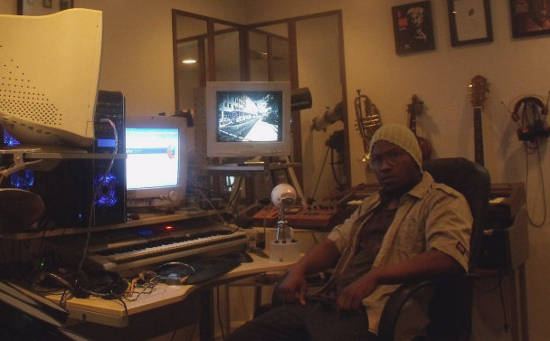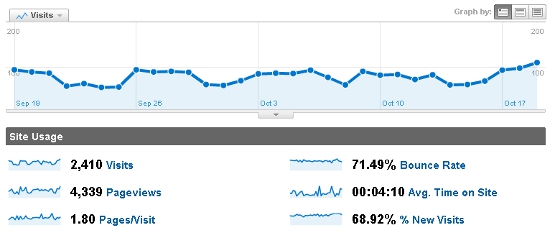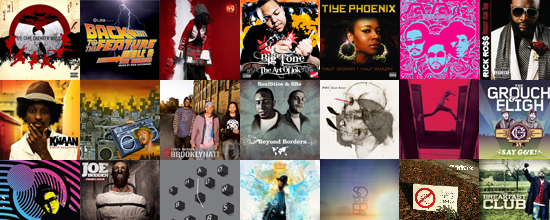SEO for Musicians
Posted by Justin Boland on Oct 20, 2011 | 0 Comments

My focus for Audible Hype is Service, service to the readers and service to the artists we’ve been featuring here. On that note, here’s an overdue primer on a frequently requested subject: SEO for artists who know all too well they’re going to have to do it all themselves. This is strictly about what you need to know to execute your plans ASAP. Dig in…
Beginner’s Luck

Back when I got into web design, the very first trick I learned remains the most useful. I’d like to pass it along to you now. You may not realize it yet, but the entire internet exists solely for the purpose of teaching you how to make better websites. All you need is the first trick: Ctrl + U
Feel free to give it a shot right now, because I’ll be using Audible Hype itself as the example for the rest of this article. Ctrl + U, or “view source,” is a keyboard shortcut that will show you the code behind anything you come across on Firefox, Chrome, or whatever else you kids do these days. This is the secret sauce that makes the internet possible. For 95% of the artists I’ve talked to in 2011, it’s also total fucking gibberish.
In a perfect world, Ctrl + U is all you’d need to know. You could sit down for a couple hours and figure everything out, right? I realize few mammals have that kind of focus or time, though, so this article is the Cliff Notes and the guided tour. This is literally everything you need to know about Search Engine Optimization on one page. Print this out and stop wasting your life thinking about it ASAP.
People hype this crap up because they have a vested interest in making it seem more important and complex than it is. I do SEO for money all the time, but what I don’t do is bullshit my clients. This is just basic due diligence, a laundry list of small menial tasks, and the reason people pay me to do it is simple: they don’t want to invest the time themselves, and they have money to throw at the problem. Since you’re here reading this, I’m betting you don’t have that luxury.

Anatomy of Your Website
URL Structure. Great news: it doesn’t matter what URL stands for. It’s just the term for the actual address of your web pages. YourName.com = the URL. Don’t let your article on SEO for Musicians have an URL like http://www.audiblehype.com/jv=?2237. You want it to be more like http://www.audiblehype.com/SEO-for-musicians
Always pack words and meaning into every aspect of your code. Never stuff it with more than 10-12 words. (In fact, forget I said that and pretend I said 5-7 words. Less work for you and more clarity for search engines.) Let this be the guiding rule as we continue through the source code…
Header Codes. One of the first thing hardcore nerds will notice about Audible Hype’s code: we don’t have meta tags in our header packed full of keywords. Content quality really does work. Good material is enough…however, if you do want to load up your header tags with keywords, there’s nothing wrong with that. After all, that’s why those fields are available.

Images. Images offer you an opportunity for more web traffic. You could skip this step, but that would be stupid. Inside of the code for every image, there are two opportunities for you to label your graphics: the ALT tag and the TITLE tag. Use them both, always. Be more descriptive than you think you should, always. The ALT tag is more for keywords, and the TITLE is a good spot for a sentence or phrase. Here’s an example: For this Adam Kadmon pic, rather than have both tags reading “Adam Kadmon,” I’ll fill the ALT tag with “Adam Kadmon music studio secret laboratory” and the TITLE tag with “Adam Kadmon reclining in his secret underground music studio.”
Why do this? Because it will bring in additional traffic from image searches. People interested in pictures are also interested in content if it looks good, and at Audible Hype, we get a healthy amount of traffic this way. Rather than just grabbing my images and leaving, they usually stick around and read something. Hopefully, it’s redundant to tell musicians they should have awesome, attention-grabbing images.
Our theory at Back Brain media is that anyone using image search is computer literate enough to be using searching for very specific content. That’s always been my specialty since back when we started Brainsturbator. This is relevant to you, because your entire career happens to be “very specific content” and you want to do everything you can to guide people to it. This brings us up to most magical-ass feature of your code, the trick that makes the entire internet possible: your links.
Links. Since you’ve got a “title” field inside the code for every link…use it. If the URL is already descriptive, make up an alternate title or description. For example, in linking to the Audible Hype article “SEO for Musicans,” I know the URL already contains all those words, so instead I’d use title=”Complete SEO Instruction on One Single Page” or something equally as retarded/catchy.
Link often. Link generously. If you’re mentioning someone and they’ve got a website, it’s a no-brainer to make that into a link. The number of connections your site has is very important — this isn’t about google rank so much as how information works as an ecosystem. Reach out and make connections all over the web and you will be rewarded with more traffic. Take it on faith, do the work, then see the proof in your results. (How? More on that in a minute.)
Social Media Integration. A mouthful of jargon that boils down to “taking shit from Facebook and sticking it onto your site.” Your audience determines how you proceed here. If you’re making hip hop for a young audience, odds are they expect to have Twitter and Facebook icons branded across everything they see. Give it to them.
Using and Understanding Analytics

Bounce Rate. Simple: this is how often people go to a page on your site, then bounce. They either got what they wanted and moved on, or they were so crippled with laughter at your shitty graphic design they had to leave before it hit a “medical emergency” level. You want people fascinated by your website. You want them to move around in it, interact with it. You want a low bounce rate. Consider anything below 50% pretty darn good. Consider anything below 20% successful enough to stop worrying about it.
Average Time. Even simpler: if you’ve got your music up on your site and the average time is less than 2 minutes, you need to start asking yourself some uncomfortable questions. (We’ll discuss strategies to make people stay longer in the next section.)
Define “Conversion.” You need clarity on what you want people to do. For the World Around site, we don’t have product for sale on the site or the member account back end running yet, so we’re not looking for sales and we’re not looking for signups. Right now, our website is a gigantic global radio station that’s always on somewhere: we want people to listen. So the most important metrics (numbers) we’ve been looking at is hits to our album pages, and the average time spent there.
This is going to change your perspective, and that’s good. For instance, you’d think that 500 hits from StumbleUpon, a very dope service that gives you randomized website recommendations based on your tastes, is a much better thing than 50 hits from Last.fm, a music discovery / social recommendation site. However, we found out that the StumbleUpon traffic mostly stayed less than 3 minutes, but the Last.fm visitors stayed for an average of 28 minutes. Because we’ve got clarity on what we want, we know we can ignore promotion on StumbleUpon and focus on tightening up our presence on Last.fm — that’s where the listeners are coming from.
Return Visits. Or as you like to call them, “your fans.” If you’re not getting many return visits, that’s not a good sign. I’d like to share another useful Life Rule with you, one that’s served me well since I was 15: “TOO MUCH is always better than NOT ENOUGH.”
Lots of return visits is, of course, a “good thing,” but it’s more complex than that. When you have a dedicated audience that keeps coming back, you’ve also created a feedback loop that those of us in the content industry call The Gaping Maw. As you can imagine, The Gaping Maw must be fed, constantly. More return visits amounts to more of an obligation to provide them with more new content.
As problems go, though…not a bad one to have, eh?

Content Matters More than SEO
Schedule, Don’t Obsess. Whether you call it “analysis paralysis” or “the Paradox of Choice,” it boils down to this: free time is kinda dangerous. You can spend 8 hours at a stretch looking over your data, tinkering with your code, and reading up on blogs about blogging — but not one minute of that time is going to make a difference to your career and your bottom line. This is a guide aimed at discouraging your interest in SEO, so I advocate visiting Google Analytics exactly once: the time you setup your account and then schedule your automatic updates. This means GA will be sending a PDF report to your email inbox once a week, and it’s definitely the most mentally-healthy way to deal with this flood of information.
Besides, only the big picture matters here. You want to see the overall patterns that emerge, not be constantly checking up on meaningless details that do not help you move your career forward, and definitely do not help you with songwriting or beat production or mixing or any of the 10,000 things you should be doing instead.
Do one audit. Just one. Tune out everything else, turn off the phone, sit down and do an honest assessment of everything online that has your music on it. Make a list of these pages and take notes on what needs to be done. Look at everything like you’re seeing it for the first time. You can execute this entire strategy in less than two hours if you focus on only this.
Remember, the benefits of SEO…and social media, and touring, and in fact all promotion of any kind…are relative to the amount of time you have to invest executing the work. Simple is powerful. Get what you need done accomplished, and remember that 99.9% of what’s been written about SEO in human history has nothing to do with your goals. WHALAM!!
